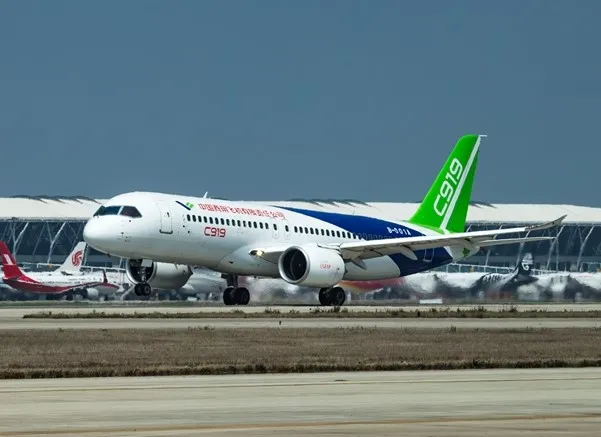
COMAC C919 achieves first flight milestone
May 07, 2017

The COMAC C919, China's first domestically developed narrow-body airliner, has successfully completed its inaugural flight, marking a significant milestone in the nation's aviation industry. This achievement demonstrates China's growing capabilities in aerospace manufacturing and technology, positioning the C919 as a competitor to established aircraft like the Boeing 737 and Airbus A320. During the flight, the aircraft performed various tests to assess its systems and handling characteristics, all of which were executed smoothly. The C919 aims to meet both domestic and international market demands, with hopes of enhancing China's presence in the global aviation sector.
Overview of the COMAC C919
The COMAC C919 is a narrow-body twin-engine jet designed and manufactured by the Commercial Aircraft Corporation of China (COMAC). It aims to compete with major aircraft like the Boeing 737 and Airbus A320. The C919 project is part of China’s larger goal to establish a self-sufficient aviation industry and reduce reliance on foreign manufacturers.
First Flight Milestone
On May 5, 2022, the COMAC C919 achieved a significant milestone by successfully completing its first flight. This flight marks a crucial step in COMAC's journey towards introducing the C919 into commercial service. The aircraft took off from Shanghai Pudong International Airport, demonstrating various flight functions and systems. The successful first flight is a testament to the extensive research and development efforts put into the project.
Significance of the First Flight
The first flight of the COMAC C919 is more than just a technical achievement; it represents China's ambitions in the global aviation market. With this milestone, COMAC aims to showcase its capabilities in aircraft manufacturing and challenge the dominance of Western manufacturers. The aircraft is designed with cutting-edge technology, making it competitive in terms of fuel efficiency and passenger comfort.
Technical Specifications
Here are some of the key specifications of the COMAC C919:
| Specification | Details |
|---|---|
| Length | 38.9 m |
| Wingspan | 35.8 m |
| Height | 11.5 m |
| Maximum Takeoff Weight | 72,000 kg |
| Passenger Capacity | 158 to 168 |
| Range | 5,555 km |
Features of the COMAC C919
The COMAC C919 comes equipped with several advanced features aimed at enhancing passenger experience and operational efficiency:
- Advanced Avionics: Incorporates modern cockpit technology that improves flight safety and operations.
- Fuel Efficiency: Designed to be more fuel-efficient than its competitors, reducing operational costs for airlines.
- Comfortable Cabin: Features a spacious cabin layout that enhances passenger comfort.
- Noise Reduction: Engine design focuses on minimizing noise pollution, making it environmentally friendly.
Market Impact
The successful first flight of the COMAC C919 could potentially disrupt the aviation market, which is predominantly controlled by Boeing and Airbus. With increasing demand for air travel in Asia, especially in China, the C919 could provide airlines with a viable alternative to foreign aircraft. As the global aviation industry recovers from the pandemic, the timing of the C919’s entry into the market is crucial.
Future Development Plans
COMAC is not resting on its laurels after achieving the first flight milestone. The company has laid out an ambitious roadmap for the C919, which includes:
- Certification Process: The next step involves obtaining necessary certifications from aviation authorities, including the Civil Aviation Administration of China (CAAC).
- Commercial Launch: After successful testing and certification, COMAC plans to launch the C919 commercially, targeting domestic and international airlines.
- Future Models: There are plans to expand the C919 family with larger variants to cater to different market segments.
Challenges Ahead
Despite the excitement surrounding the C919, several challenges lie ahead:
- Regulatory Hurdles: Gaining certification from international aviation authorities can be a lengthy and complex process.
- Competition: Competing against established players like Boeing and Airbus will require significant marketing and strategic partnerships.
- Supply Chain Issues: Ensuring a reliable supply chain for components is critical for production and delivery schedules.
Conclusion
The achievement of the first flight milestone by the COMAC C919 is a significant development in the aviation industry. As the aircraft moves closer to commercial operation, its impact on the market will be closely watched. With its advanced features and competitive pricing, the C919 has the potential to become a key player in the global aviation landscape. The coming years will be crucial for COMAC as it navigates the challenges of certification, competition, and production to bring the C919 to airlines around the world.
Related Articles

Explore Thailand: The Best Islands to Visit for Paradise, Adventure, and Relaxation

The Ultimate Guide to the Best Islands in Thailand for Your Next Getaway

Do babies need passports? How to get a passport for a newborn

How to get a U.S. passport fast: here’s how to expedite the process

What is Mobile Passport Control: 5 reasons why you should use it

SENTRI vs. Global Entry: A detailed guide

Do you need a passport to go to the Bahamas? Let’s find out

Do you need a passport to go to Mexico? A detailed guide

Do you need a passport to go to Canada? We got the answer

Do You Need a Passport for a Cruise: An Essential Travel Guide

Booster Seat Requirements: All the Rules to Follow in Your Rental Car

What Are the World’s Most Powerful Passports, and How Does Yours Rank?

How to Take a Passport Photo at Home: A Helpful Guide

You've got to have heart! Southwest's new livery

Your opinion: Should water be free on low cost carriers?

Young women bolder than guys as solo travellers
